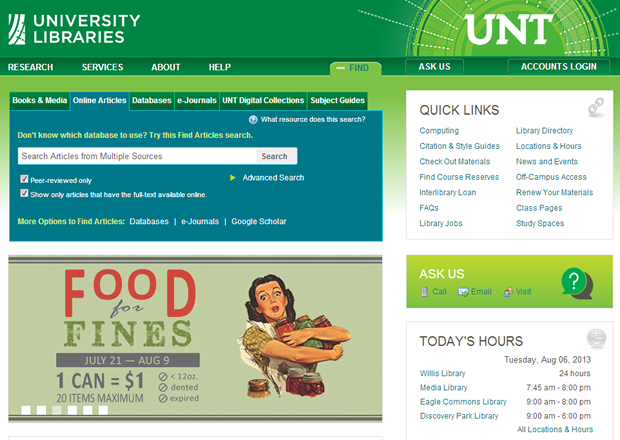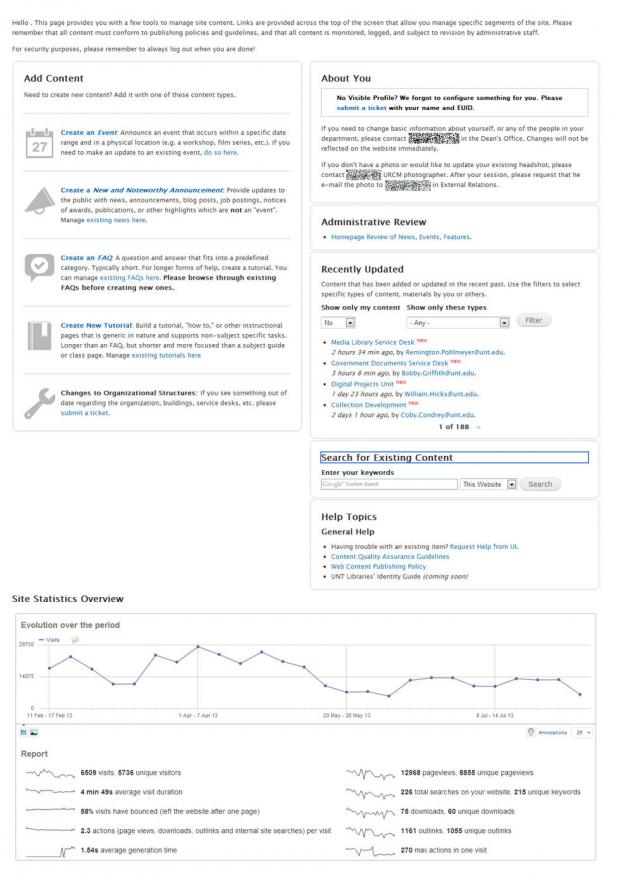 Support for Drupal 7 is ending on 5 January 2025—it’s time to migrate to Drupal 10! Learn about the many benefits of Drupal 10 and find migration tools in our resource center.
Support for Drupal 7 is ending on 5 January 2025—it’s time to migrate to Drupal 10! Learn about the many benefits of Drupal 10 and find migration tools in our resource center.The University of North Texas Libraries (UNTL) is an academic library system that serves more than 33,000 students and over 2,000 academic staff per semester. The UNTL Website is the online traffic control tower of the libraries that guides our patrons to discover the access to over 6 million print and digital resources along with many services offered by the UNTL.
In 2012, the User Interfaces Unit (UI) at the University of North Texas Libraries led the charge to migrate the Libraries' website from Plone 2 to Drupal 7. This transformation enabled the UNTL to deploy new content strategy for creating and managing context-driven content, streamline the website information structure, improve the end-user experience, and update the look and feel of the website to closely adhere to the University’s brand principles.

In summer 2007, UNTL selected and migrated to our very first content management system -- Plone 2. At that time, Plone was one of the more mature, capable and user-friendly open source CMS out there. It scored highest during our CMS selection process over Drupal, Joomla, and few other proprietary CMS.
5 years later, even though Plone 2 was still functional and stable, our libraries' evolving content management and user needs simply out-grown what Plone 2 could offer. We were facing the options of either upgrading to Plone 4 or migrating to another Open Source CMS.
Why we migrated from Plone 2 to Drupal 7:
• Although Plone is still a very relevant Open Source CMS/CMF solution, in our opinion, Plone, comparing to Drupal, doesn’t offer the same scale of community support, the openness, the responsiveness, the extensibility, the flexibility, and the large number of freely available add-on modules/themes.
• More and more on-campus groups at our university started to deploy Drupal since 2010, it made sense to us to migrate to Drupal in order to utilize the ever-growing on-campus Drupal community support
• Our unit was lacking of in-house python developers at the time. The steep learning curve that was required to complete the upgrade from Plone 2 to Plone 4 offered little incentive for us to stay with Plone.
The primary goal of this project was to address the identified issues with the old website and to implement a new web experience that will meet the following objectives:
• Committing to analytical data driven design approach to increase discoverability to the highly utilized online features of the UNTL
• Shifting from organizational structure driven information architecture to user stories based content organization
• Refactoring the staff-end user interface to make the creation and management of content more intuitive
• Streamlining the content review workflows to reduce bottleneck
• Increasing the use of online marketing features to promote better awareness of UNTL’ services, events and holdings
• Deploying new content strategy to deliver contextually related content more cohesively
• Implementing new look and feel to reflect the University’s new branding identity
After 9 months of planning and development, the new library website launched at the end of July 2012 just in time to welcome the beginning of the fall 2012 semester.
Some of the highlights of this new website include:
• Improved search boxes display location with enhanced search options
• Added dynamically generated today's building hours for each library branch
• Improved the contextual display of hours, locations, contact and services information
• Introduced a jQuery collapsible "Find" tab throughout the site that provides quick access to frequently used site features
• Redesigned “News & Events” section with many added features to help draw attractions to the Libraries' collections, happenings, and services
• Improved scenario-oriented information architecture
• Built an intuitive staff-end interface layer for improving usability and reducing Drupal learning curve
• Adopted the new University Branding
Note on content migration from Plone 2 into Drupal 7
With the help of using Feeds, Feeds Tamper and Job Scheduler modules, migrating content into Drupal 7 was the easier part. The challenge we were facing is the lacking of fields mapping options for migrating source data out of Plone's flat file system into the Drupal database.
What we ended up doing was to tackle the data export from Plone via page scraping, and then structuring those data into XMLs. Once the XMLs were generated, importing them into Drupal was pretty straightforward.
Please feel free to read our entire Project Plan.
Technical specifications
The Views module, in our experience, is THE ONE to use for querying data out of the database and developing the fundamental site building blocks. For building and delivering all the context-driven display components of this site, the following are the key contributes modules this site can’t live without: Panels, Context, Views, Views PHP, Date, Token and Entity Reference, etc.
For content migration into Drupal, we used the Feeds + Feeds Tamper. It is a handy, simple to use but powerful combination.
What did we use for shipping deployable functions from the development environment to the production environment for this site? Yes, your guess is right – Features.
Core Project Team:
- Neena Weng
- William Hicks
- Jason Thomale
- Dianne Jansing
- John Luetkemeyer
- Garret Rumohr
- Caroline Lara
